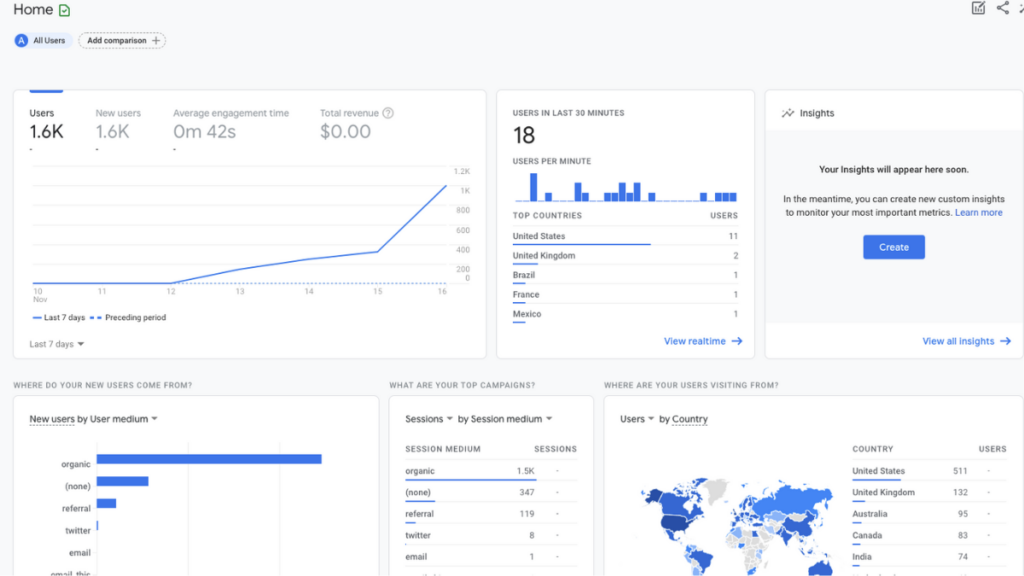

It happens.
Not all users use the same device when it comes to logging in to a website.
For example, a person can use three different devices—a mobile phone, a laptop, and a desktop PC—to log in to your website.
In this case, although the user is the same, the analytics tool can report three different users to you.
Yeah, this doesn’t cause any harm to your website.
But it will make the count of visitors misleading.
This is because Google Analytics can show that three users have visited your website while it was the same user just using different devices for sign up.
Luckily, Google Analytics comes with an important feature called User ID to address this issue.
Once the User ID feature is activated, Google Analytics shows the users as the same even if the sessions are accessed through different devices. Otherwise, we would be reporting three users although the users are one with three devices—three devices—three sessions.
In other words, the user will be shown “single” or a separate user, regardless of the devices used by him to log in to your website.
He or she won’t be turned into multiple users as they switch to other devices.
This way, this feature helps keep user count more accurate.
So What is This User ID Anyway?
User ID in Google Analytics is a set of alphabets and characters like this (ga(‘set’, ‘userId’, USER_ID);).
It is assigned to a user so that he can be identified across devices/browsers and over multiple sessions while logging into a website.
When it is activated in your Google Analytics, it considers each unique User ID as a separate user (no matter what they use to sign in to your website), thereby providing a more accurate user count in your reports.
This is an important feature that lets you tie sessions together when the User ID is the same, even if the sessions are made on different devices. Therefore, the user will be counted as one.
Here is an example of how User-ID in Google Analytics works—
If someone logs in to your website on their mobile device, then on their desktop, and then on their tablet, you can tie these three separate sessions together and you’ll have a single user reported inside Google Analytics.
This way, it keeps your user count more accurate.
Plus, it helps you understand how users interact with your website as a user might use a mobile phone to find your website and then use a laptop to shop.
Don’t Confuse Google Analytics User-ID with the Client ID
Google Analytics User-ID and Client ID are not the same.
A client ID means a unique device or browser used by a visitor to access your website. A user ID, on the other hand, means a unique user that can use any device to log in to your website.
What are the Benefits of Google Analytics User ID
Giving You More ACCURATE User Count:
Like I have said before, many people use different devices to log into the same devices. This could send misleading data as the tracking tool can count the same person as two.
Every unique user ID is considered to be a unique user in the Google Analytics reports, no matter what devices they are using to log in to your website. This way, you get more accurate user data.
Letting You Analyze the Signed-In User Experience:
User-ID can be incorporated with your authentication system, so the unique ID that is utilized to identify a user account is sent to Analytics as the User ID. Any activity that takes place when an account is logged in can all be associated with that ID.
This is because a logged-in user interacts with the content differently than users that don’t log in. An eCommerce site is a perfect example in this case.
Accessing Special Tools and Reports in the Analytics Account:
User-ID also lets you access User-ID reporting views and the Cross-Device reports.
Talking about the User-ID view, it is a special reporting view that lets you analyze the traffic associated with the users that log in to your website.
With Cross-Device Report, you can analyze how users engage with your content on different devices throughout multiple sessions.
These two features give you a better picture of the traffic and behavior of your signed-in users.
Providing Valuable Data:
The data collected through User-ID is valuable. It helps you find and analyze relationships between various devices and activities across several sessions.
Therefore, you can see what those signed-in users do between these important action points.
This data can be used to create new kinds of marketing strategies according to the different devices and engagement.
BUT GOOGLE ANALYTICS USER ID HAS ITS OWN LIMITATIONS…
User ID is really useful, but it is not perfect either.
Why?
Well, the User ID feature can capture the insights for those people who do actually log in to your website.
User ID feature is only useful when you have a sort of “log in” or user authentication system in place.
But not all people might have logged in to your website.
If they haven’t logged in and the User ID hasn’t been sent, then Google Analytics can’t tie the data together.
Simply put, User-ID requires visitors to log in some way, either through a login or registration.
How to Use User-ID When You Lack Any Sort of Log-in?
If you have other ways of identifying people than “log in” systems as they access your website, app, or other touchpoints, then User ID can still be useful.
Let’s say you collect email addresses on your website.
Those email addresses then get stored in your email platform and that platform assigns a unique ID to each person that subscribes. You can then add that ID to the URLs contained in the emails you send.
As people click through to your website from your emails, the ID can be passed to Google Analytics and used to tie sessions together.
This would mean that if someone clicked through to your website on their desktop and then later on their mobile device the ID in the links would be the same and you could see the different devices people are using.
This way, you can still make use of User ID in Google Analytics without having anybody logged in to your system.
How to Create User ID in Google Analytics
The User-ID feature is available only with the Universal Analytics version.
STEPS FOR CREATING USER ID IN GOOGLE ANALYTICS
- Log in to Your Google Analytics account.
- Click Admin and then choose your GA property
- In the Property Section, click Tracking Info and then User-ID
- Read and agree to the User ID policy by turning the blue switch to ON.
- Click the “Next Step” button to get a TRACKING CODE like this (ga(‘set’, ‘userId’, USER_ID);)
(Note: Ask your developer to insert this code to the website you want to track.)
- Keep the “Session Unification” in the ON mode to avoid duplicate sessions and click on the “Next Step” button.
- To create a new user ID view, click on the “Create Button”.
(Keep in mind that the user ID data can only be viewed in the user ID view.)
- Choose the website or mobile app for the user ID view.
- Name the new reporting view and choose your “reporting time zone”.
- Click the “Create View” button.
Your new User ID view is now complete!
Once this User ID is enabled in your Google Analytics, you can track the users’ activity through features like behavior, technology, overview, custom in the Audience section given on the Home of your Google Analytics.
User ID Set Up in Google Analytics 4
Google Analytics 4 is the latest GA version. It allows webmasters to track website and app data in one property, thereby giving a big picture of data.
Google Analytics 4 uses one or both of the following IDs to track an individual user—User Pseudo ID that is set automatically and User ID that is set by you.
When setting a User ID variable, avoid setting a default value like “unknown” or “not-logged-in”. Don’t set it if the User ID is not activated.
When you set a new Google Analytics 4 property, make sure to set your “Reporting Identity” to “By User ID and Device”.
(Note: If you don’t have a User ID, you can use User Pseudo ID or By Device Only.)
The Bottom Line:
Getting accurate traffic is important for any webmaster out there. Setting up a User-ID feature in Google Analytics will give you a more accurate user count.
It eliminates the odd of getting false data reported with the cross-device interaction of a single user. Moreover, it helps determine the behavior of the visitors as they use multiple devices to access your website.
What do you think?
How setting up User ID in GA has helped you? Or let me know if you face any problem with its set-up? Just drop your comments in the box given below!

Started working as a digital marketing expert, Varun Sharma is now also a well-known digital marketing speaker – a speaker on performance development, and a trusted mentor to businesses in the digital world. His keynote expositions are based on the digital marketing theories, which provide a fascinating insight into the secrets of high performance.

